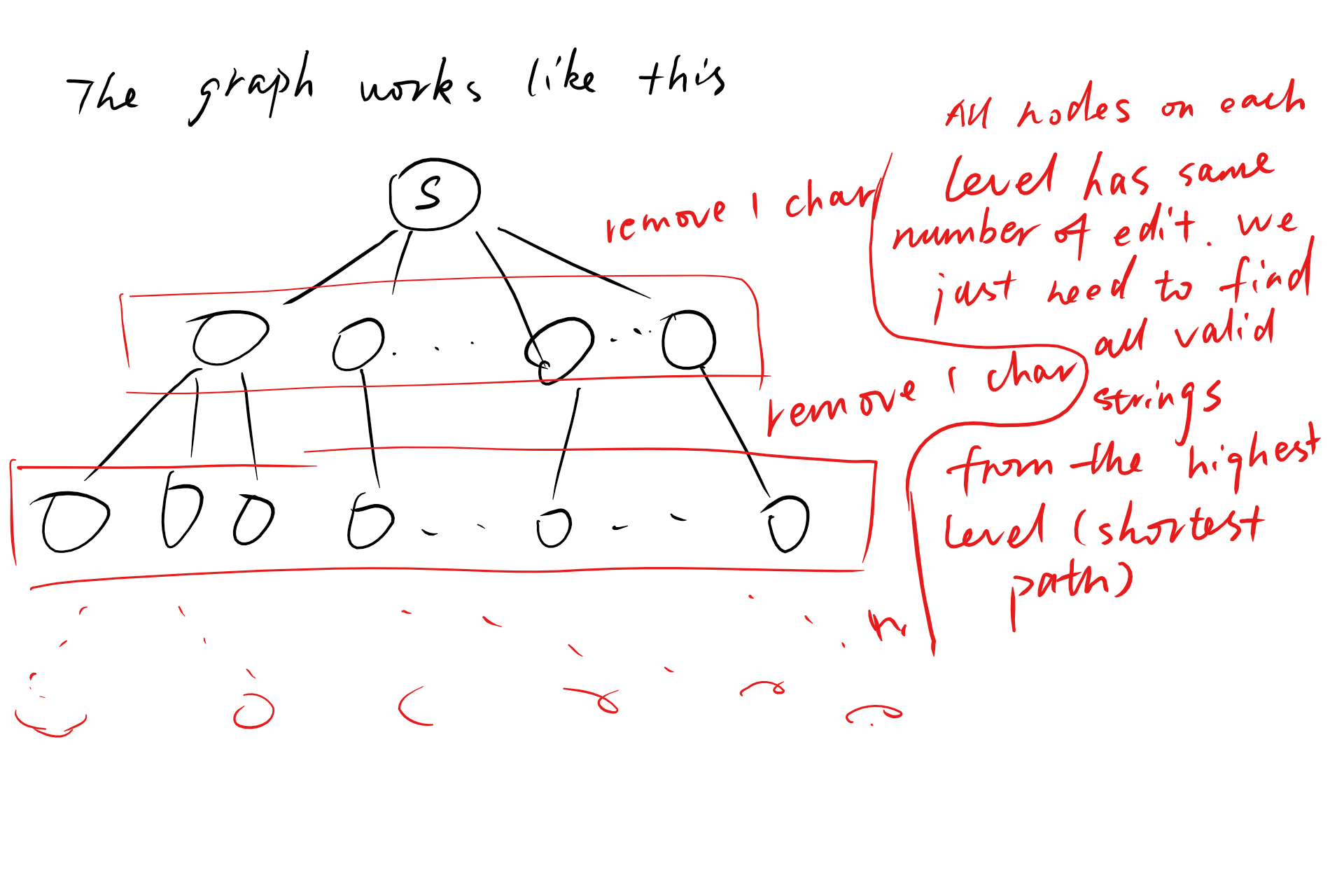301 - Remove invalid parentheses
Remove the minimum number of invalid parentheses in order to make the input string valid. Return all possible results.
Note: The input string may contain letters other than the parentheses ( and ).
Examples: "()())()" -> ["()()()", "(())()"] "(a)())()" -> ["(a)()()", "(a())()"] ")(" -> [""]
先思考一道简单一些的,如果去掉minimum这个限制,返回一个修改后valid的,要怎么做?
我的思路是用一个counter,遇到做括号就+1,右括号就-1,invalid的情况有如下两种:
1) 遇到右括号的时候,没有左括号可以pop,namely counter is zero
2) 最后stack里面还剩左括号没有pop, namely counter is larger than zero
第一种情况skip掉这种右括号,第二种情况append counter个右括号
 如果要求minimum remove,并返回一个结果呢?这就比较tricky了, O(n)时间复杂度的算法是从左到右扫一遍,再从右到左扫一遍,用一个counter,删掉遇到的不合法的‘右’括号,这样我们就尽可能保留了左括号,从而保证minimum删除操作。
如果要求minimum remove,并返回一个结果呢?这就比较tricky了, O(n)时间复杂度的算法是从左到右扫一遍,再从右到左扫一遍,用一个counter,删掉遇到的不合法的‘右’括号,这样我们就尽可能保留了左括号,从而保证minimum删除操作。
//)(())(
public String oneValid(String s){
int counter = 0;
StringBuilder sb = new StringBuilder();
for (int i = 0; i < s.length(); i++){
char c = s.charAt(i);
if (c == '('){
counter++;
}
if (c == ')'){
counter--;
if (counter < 0){
counter = 0;
continue;
}
}
sb.append(c);
}
counter = 0;
//(())(
s = sb.toString();
sb = new StringBuilder();
for (int i = s.length() - 1; i >= 0; i--){
char c = s.charAt(i);
if (c == '('){
counter--;
if (counter < 0){
counter = 0;
continue;
}
}
if (c == ')'){
counter++;
}
sb.append(c);
}
return sb.reverse().toString();
}
再进一步,如果要返回所有valid的结果呢? 我觉得应该是用backtracking
 Now, we back to our original problem which aims to find the valid expression with minimum removals.
Treat this as a graph. Each node on graph represents the current state after modification on its parent node. Then this problem is transformed to getting shortest path(s) on a graph.
Obviously, BFS is the right track. Note, we should avoid duplicate state like we usually have a visited array to mark the nodes we explored. Same here, otherwise, the program will get TLE.
Now, we back to our original problem which aims to find the valid expression with minimum removals.
Treat this as a graph. Each node on graph represents the current state after modification on its parent node. Then this problem is transformed to getting shortest path(s) on a graph.
Obviously, BFS is the right track. Note, we should avoid duplicate state like we usually have a visited array to mark the nodes we explored. Same here, otherwise, the program will get TLE.

public List<String> minimum(String s){
if (s == null) return new ArrayList<String>();
Queue<String> Q = new LinkedList<String>();
Set<String> set = new HashSet<>();
List<String> res = new ArrayList<>();
set.add(s);
Q.offer(s);
boolean found = false;//must be defined out of the while loop
while (!Q.isEmpty()){
int size = Q.size();
for (int i = 0; i < size; i++){
String tmp = Q.poll();
if (isValid(tmp)){
res.add(tmp);
found = true;
}
for (int j = 0; j < tmp.length(); j++){
if (found) break;
char e = tmp.charAt(j);
StringBuilder sb = new StringBuilder(tmp);
if (e == '(' || e == ')'){
sb.deleteCharAt(j);
}
if (!set.contains(sb.toString())){
set.add(sb.toString());
Q.offer(sb.toString());
}
}
}
if (found) return res;
}
return res;
}
private boolean isValid(String s){
int counter = 0;
for (int i = 0; i < s.length(); i++){
char c = s.charAt(i);
if (c == '('){
counter++;
}
if (c == ')'){
counter--;
}
if (counter < 0) return false;
}
return counter == 0;
}